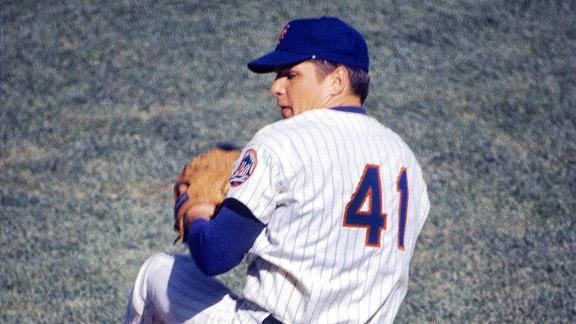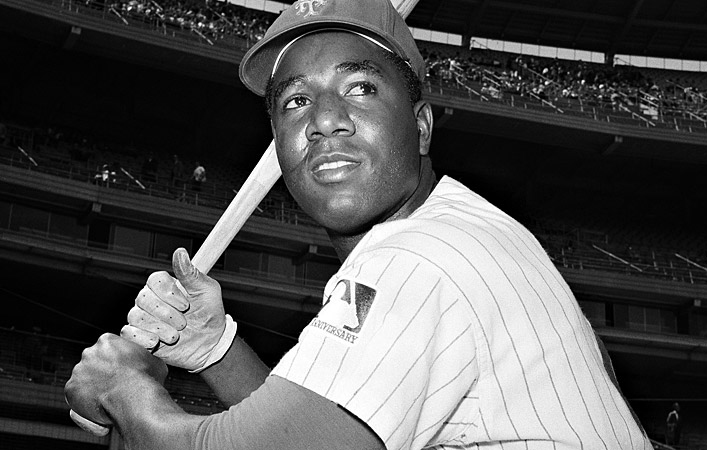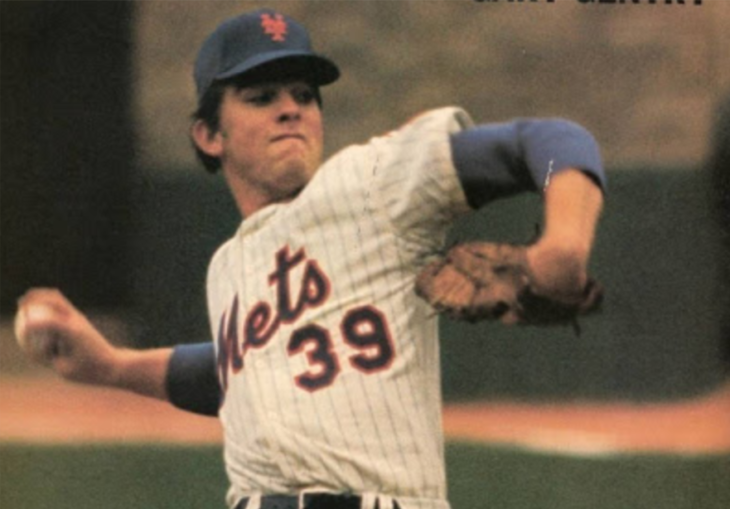
1969 New York Mets
Earlier this week, Marshall Field of MMO detailed the first half of the New York Mets’ magical, world championship, 1969 season — The Miracle, Part 1. Join us as we continue to celebrate the 50th anniversary of the 1969 World Series champion New York Mets with part two of the series.
Coming out of the 1969 All-Star game on July 23, the New York Mets’ record stood at 53-40, leaving this upstart group just six-games behind the Chicago Cubs. From July 24 through the end of the month, the Mets lost five-of-seven, including a potentially demoralizing doubleheader sweep at the hands of the Houston Astros on July 30.
Left-hander Jerry Koosman allowed five runs over seven innings, and Cal Koonce and Ron Taylor gave up 11 more over the final two innings in the first game, then Gary Gentry allowed eight runs on five hits and three walks over 2.2 innings and Nolan Ryan allowed three more over 4.1 innings in relief in the second.
This young Mets team could have rolled over, settling into their place among the National League’s mediocre, but instead reeled off three wins in a row to start a now-legendary August, including a thrilling 6-5 walk-off win over Atlanta on August 3, with Jerry Grote‘s 11th-inning dinger deciding the contest.
The Mets then lost three-of-four in Cincinnati, with Koosman taking a tough loss on August 4. Despite throwing seven innings of one-run ball, Reds’ righty Jim Maloney put up goose eggs across 8.2 innings of work (just three strikeouts), allowing Alex Johnson‘s sacrifice fly in the third scoring Pete Rose to stand up as the game-winner.
Seaver allowed four runs over three innings, boosting his ERA to 2.66 on the year — to give an idea of just how Terrific he’d been that season — in another loss to Cincy on August 5, and things were looking a bit bleak in Flushing.
Heading into a four-game series with Atlanta beginning on August 8, the Mets were 8.5 games out of first and needed some wins to keep themselves within striking distance in the National League East.
The National League West-leading Braves, led by Hank Aaron, Felipe Alou, Orlando Cepeda, and future Mets infielder Felix Millan, were a force, no doubt. Between a young Phil Niekro baffling batters to the tune of a 2.56 ERA and Cecil Upshaw emerging as an absolute force in relief, this team had all the necessary moving parts of a true contender.
In a sign of things to come, the Mets played up to their competition and nearly swept the Braves in Atlanta, losing on a 10th-inning RBI single via Alou to score Clete Boyer in the series finale. Talk about a confidence booster, huh? Not so much. Those darned Astros took a three-game sweep from the Mets, this time in Houston, leaving the Amazins ten games back on August 13.
Let’s go ahead and pause the story for a second.
I’m 35 years old. My father was 12-going-on-13 during the summer of 1969. I’ve been hearing about the upcoming stretch I’m about to detail for as long as I can remember. I’m going to do my best to bring you through this historic run through the eyes of someone who lived it. I just wish he were still here to fill in the gaps. Enjoy.

The Mets took four games from the San Diego Padres over the span of two days (August 16 and 17; rainout on August 15), with Seaver, Jim McAndrew, Koosman, and Don Cardwell allowing just five runs over 34 combined innings and kicking off one of the more improbable runs in the storied history of professional sports, propelling them back into second place in the NL East, eight games back.
At this point in the season, guys like Cleon Jones (.347/.433/.517, 12 homers, 67 RBIs), Art Shamsky (.316/.402/.497, nine homers, 27 RBIs), and centerfielder, Tommie Agee (.276/.336/.495, 20 homers, 57 RBIs) were leading the way, offensively, but we’d be remiss to leave out the significant contributions of guys like Ed Kranepool — the original Mr. Met –, sparkplug infielder, Bud Harrelson, and newcomer/linchpin, Donn Clendenon (more on him shortly).
Seaver (18-9, 2.55 ERA on August 17), Koosman (14-8, 2.23 ERA on August 17), and Cardwell (10-14, 3.45 ERA) had been more than solid up until that point, and McAndrew was slowly coming along (4.50 ERA), but things were about to shine even brighter for this group.
On August 19, the Mets began a torrid stretch, winning 10-of-13 through the end of the month, including six in a row over the Dodgers and Padres (August 22 to August 27) and two walk-off wins (Agee HR on August 19; Grote RBI double on August 23).
While the Mets were solidifying themselves as a bonafide contender, the Cubs were simply falling apart. From August 20 through August 27, Chicago lost seven-of-nine and watched their lead in the East dwindle to just 2.5 games.
The Cubs winning four in a row to end August and the Mets splitting four games in San Francisco left New York 4.5 games behind Chicago heading into September. With just four games left scheduled between the two teams before the end of the season, any gains would have to be made on each respective squad’s own merits.
The Mets began September with a hard-fought series loss to the Dodgers in Los Angeles. After splitting the first two games of the series, Agee and Clendenon homered off Los Angeles starter Claude Osteen in the eighth to tie the game at four, but Willie Davis laced a double into left field with two outs in the ninth off Pete Mikkelson, scoring Maury Wills and giving LA a 5-4 win.
The Cubs won their first game of the month, an 8-2 laugher over Cincinnati on September 2, then proceeded to lose four in a row heading into a much-anticipated two-game series in Flushing Meadows with their lead in the NL East back down to 2.5 games over the Metsies, who just took three-of-four over Philadelphia at home.
It was go-time, folks.

On September 8, behind a 2-for-3 day from Agee with a two-run homer and a double and a complete game effort from Koosman (13 strikeouts, two walks), the Mets beat the Cubs, 3-2, cutting the Mets’ deficit in the East to a game-and-a-half.
On September 9, oddly enough, what happened between the lines on that Tuesday evening at Shea isn’t what stands out in most fans’ minds. It’s the appearance of one of the more ominous and superstitious creatures in folklore.
The black cat who slinked across the on-deck circle — pausing to peruse the scene — and darted underneath the field-level grandstand at Shea while Ron Santo was awaiting his turn at-bat, turned out, fifty years later, to be the star of the game.
Whether you buy in to the existence of hexes et al or not, with the way things were going for both teams involved in this now-legendary pennant race, it certainly provided an outstanding sideline for fans and sportswriters to latch on to.
Art Shamsky spoke about the feline’s cameo to the New York Post just this week, acknowledging the timing and peculiarness of the moment, but seemed all the more pleased it occurred.
“We’re all very superstitious, and it was just an incredible moment in a year of a lot of incredible moments for us, the city, and the country,” Shamsky told Peter Botte of the Post. “Who knows? I don’t know if it had a direct effect on [Chicago] or not. All I know it just really eerie; like somebody sent it. It was so freaky, but I’m sure glad it happened.”
On the field, behind another terrific start from Seaver (complete game, one run on five hits, five strikeouts, and a walk; 21-7, 2.43 ERA), home runs via Clendenon and Shamsky, and another solid day at the plate from Agee (2-for-4; up to .285/.348/.504 on the year), the Mets hung seven runs (five earned) on future Hall of Famer Fergie Jenkins, and beat Chicago, 7-1, slicing the Cubs’ lead down to just a half-game.

The following day, facing the Montreal Expos in a Wednesday doubleheader, the Mets took the opener in walk-off fashion, with Ken Boswell driving home Cleon Jones with a single into centerfield off Montreal’s Bill Stoneman, giving the Mets a 3-2 win in 12 innings.
Riding an outstanding start from one of the many young, talented right-handers bubbling up through their organizational ranks, Nolan Ryan (complete game, one run on three hits, 11 strikeouts) and a 3-for-4 game from Boswell, the Mets beat the Expos, 7-1.
With that victory, the New York Mets did something most baseball fans had never thought possible so early on in their mostly-inept history; they overtook the Cubs — who lost, 6-2, to the Phillies — and moved into first place in the National League East for the first time in the franchise’s short existence.
Waking up on September 11 with a one-game lead and 21 games left to play, the New York Mets won seven of eight through September 18, building a commanding, five-game divisional lead over Chicago.
After losing the first three of a five-game series against the Pittsburgh Pirates, the Mets were still four games up on the Cubs thanks to the continued ineptitude of those boys from the North Side. The Cubs went 8-17 in September and, by all accounts, were simply outlasted and outplayed by a better, hungrier Mets ballclub down the stretch.
One could rationalize that with a comfortable lead over their rapidly-fading competition, the Mets could simply coast to the first divisional title in their eight-year history. Or, they could slam the pedal to the floor and head into the postseason with a head full of steam. They chose the latter.
From September 21 through the final game of the season on October 2, the Mets won nine-of-ten, including a thrilling, 3-2 walk-off win over St. Louis on September 23 (Harrelson single off Cards starter Bob Gibson, still pitching in the bottom of the 11th, to score Ron Swoboda).
The pinnacle of this organization’s short time in Major League Baseball up until that point, their 6-0, National League East-clinching win over the Cardinals, came the following day.

In front of 54,928 fans at Big Shea, Gary Gentry pitched a complete game shutout, outdueling future Mets nemesis, Steve Carlton (who struck out 19 Mets in a game just 10 days earlier), Donn Clendenon hit two home runs, Ed Charles added another, and when the Cards’ Joe Torre grounded into his game-ending 6-4-3 double play, absolute bedlam ensued.
As Leonard Koppett of The New York Times wrote on September 25, 1969,
“As the players raced for the clubhouse for their own celebration, thousands of spectators leaped railing and quickly filled the field, roaring, and chanting, ‘We’re No. 1.’ For the next 20 minutes, at least, the cheering and milling continued, until the lights were dimmed and a slow dispersal began”
“All concerned were full and joyfully aware of what the victory meant. The Chicago Cubs […] had won their afternoon game, precluding the possibility that the Mets would clinch before taking the field. But to perform the clincher at home, before the fans who have been such an integral part of the club’s peculiar history, the Mets had to win this game, the last scheduled for Shea Stadium.”
And that they did, winning their first division crown exactly one year, to the date, manager Gil Hodges suffered a mild heart attack in the dugout in Atlanta.
From that now-infamous date of August 13, when the Mets were ten games behind Chicago, until the end of the season, the Mets made up not just those ten games but ended up winning the division by a whopping eight games over the Cubs — a nearly-unbelievable 18-game turnaround.
Over those final weeks (from August 13 on), Tom Seaver (9-1, 1.24 ERA), Jerry Koosman (8-1, 2.35 ERA), Don Cardwell (6-1, 1.53 ERA), and Jim McAndrew (5-3, 1.97 ERA) set the tone on a daily basis, and with authority, to boot.
That starting pitching, along with the oodles of depth this team had littered throughout the rest of their pitching staff, would prove to be what set the NewYork Mets apart from their competition in 1969.
With their sights set on a much more prestigious prize, the Mets set forth toward their first foray into MLB postseason play. And they were ready for it.
Stay locked onto MMO for the final installation of our 1969 Miracle Mets series, The Miracle Realized, coming this weekend.














